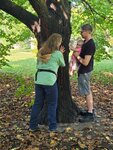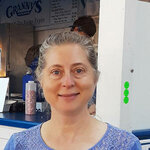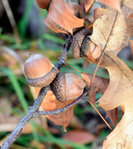By Shevek McKee, Executive director, district10@district10comopark.org
Last year, D10 Como Community Council received a grant from the Saint Paul Audubon Society to support a new initiative for the Como Park Tree Trek. For several years, the Tree Trek program has tagged Como Park trees and provided an accompanying self-guided map but thanks to the new funding, the program has expanded content with Meet the Trees.
Our Tree Trek guide, Stephanie Mirocha, spent countless hours last year writing thorough and personalized tree species write-ups with photos for all 41 tagged tree species in Como Park. Stephanie thoughtfully sorted the photos and formatted the writing to suit ideal implementation into the D10 website. Even so, it took staff five months to complete the content transfer piecemeal between regular duties. The content is so vast it was technologically disruptive to contain on a single page so each species has its own page!
It was wonderful to see that, like the experience of attending one of the guided Tree Trek events (the next on June 22, 10 a.m. to noon), the written content is not only informative but filled with personal touches and fun quirks. While the photographs document the trees and stages of their seeds, many of them are also simply gorgeous and betray to the viewer Stephanie’s multitude of artistic talents (check out her website).
Below, Stephanie shares more about the history of the Como Tree Trek and how Meet The Trees came about:
2022 Tree Trek
I grew up riding my bike through Como Park, running through the woods, and climbing trees. Though I don’t live in St. Paul currently, Como Park and the neighborhood area will always be my home.
My dad, Chet Mirocha, was a Professor of Plant Pathology at the University of Minnesota (UMN). After he retired, he started something new for him, enlisting help in learning about tree identification and tree diseases. He had a lot of fun with that, and started leading his tree treks under the auspices of the District 10 Environment Committee in 2004, of which he was a newly active member for the community. Later, he had the idea for attaching tree ID tags, and, by 2011, these new tags were attached to 18 trees in the park. He also helped create a map on the District 10 website pinpointing the 18 trees that were labeled. The map could be printed out. My dad stopped leading Como Park tree treks sometime after 2013.
My involvement began after he passed away in 2019. At that point, I became very interested in learning about the scientific study of trees. Like him, I followed a path that was new for me. My dad and I both shared a great love of trees and nature, and also like him, I “speak for the trees.” That is the legacy I continue.
My newfound interest in dendrology, or the scientific study of trees, combined with my activities as a newly graduated UMN Master Naturalist in 2020 led me to the idea of taking up and carrying on the tree trek event that he began and which by then had fallen to the wayside. In 2020, I asked for and received permission from District 10 to go ahead with reinstating the Como Tree Trek event which I was very enthusiastic about. I began leading tree treks that year, and have done so ever since, now twice a year, usually one in June and one in autumn.
Right off the bat while leading my first tree trek, I spoke with one of the Environment Committee members on the trek that day, Susan Jane Cheney, and expressed to her my wish to expand from the 18 identified trees because there is such a variety of species in the park to learn about. She agreed with the sentiment, brought this project proposal to the committee, and ended up accompanying me on some of my forays through the park choosing and tagging trees. Her support was very important to me, and I ended up making a new friend to boot! The project was okayed, and thus began the fun work adding the 41 trees that are currently labeled with tree ID signs today. I spent many hours surveying what trees were in the park and choosing which ones to add to our list expansion. Several of the tree tag species were not available from the tree sign company, so I wrote the text for some of these for custom ordering.
Shevek McKee came on board in June 2021 as the new Executive Director of District 10 and was there when the first order of tree tags arrived. He was enthusiastic about updating the website, bringing his interest and expertise in that area. His first idea was for all the tagged trees to be updated using their GPS locations on a new map, and further, that they should have QR stickers on them to connect people to the “Tree Trek” page of the District 10 website. So, as I tramped through the park that year choosing and tagging trees, I also took their GPS locations and sent those to Shevek to create the new map.
By September 2022, volunteers on the Environmental Committee had placed QR stickers on all the tree signs. My dad’s first map did not have GPS, but I liked the fact that it was printable. A map makes it so fun! I wanted to continue to offer that option, as well. So, I asked my daughter, a geologist who works with data mapping, if she could create a new one for the District 10 website tree trek page. The map is now available to print from the website.
So, now we come all the way back full circle to the Meet the Trees activity. The idea for this project blossomed early on during some of my first tree treks, when I realized what a great resource the website could offer alongside the tagged trees with their QR stickers. Now, anyone can access the website any time of the year on their device to find out more. This project expands the self-guided tour of 41 tagged trees beyond their locations in the park to have corresponding information for each tree located on the website. In a way, as I was writing these, it felt like I was leading a tree trek, except that instead of talking I was writing down the words!
The 41 tree write-ups will allow self-guided tree trekkers to follow the tree tags through the park, or link to the website later, while learning all about each tree species’ ID traits, their natural history and their science facts. My hope is for readers to enjoy the mix of commentary balanced with science facts that bring the trees into their own lives, getting to know our friends, the trees. I was very motivated to take this project on and it just felt right. I also knew it would be a lot of work. I don’t live in St. Paul currently, but I do visit often, so I managed my schedule to research and take photos whenever I could fit the time in.
It was always on my mind – what could be blooming or fruiting or emerging. A part of the project was supported by the St. Paul Audubon Society, but I can’t even enumerate how many hours were involved! In the end, it took a year of writing, researching, and getting out “in the field” to take photos during each season of the year for the visual phases showing the trees in flower, their winter ID traits, leaf characteristics, and seed and fruit bearing. I loved doing it, learned a lot, and it was (as I suspected) a lot of work! Readers of this article may have seen me out there in the snow, or just about any time of year, taking photos! It became pretty intense towards the end, but I at last finished up the writing and compiling of photos by early January 2024.
You can find Meet The Trees on the website, and also register for the June 22 guided Tree Trek (space is limited). We hope you enjoy learning about the trees and share this great resource with anyone you know who enjoys the park!
This article was originally published at the District 10 website.






Comments
No comments on this item Please log in to comment by clicking here